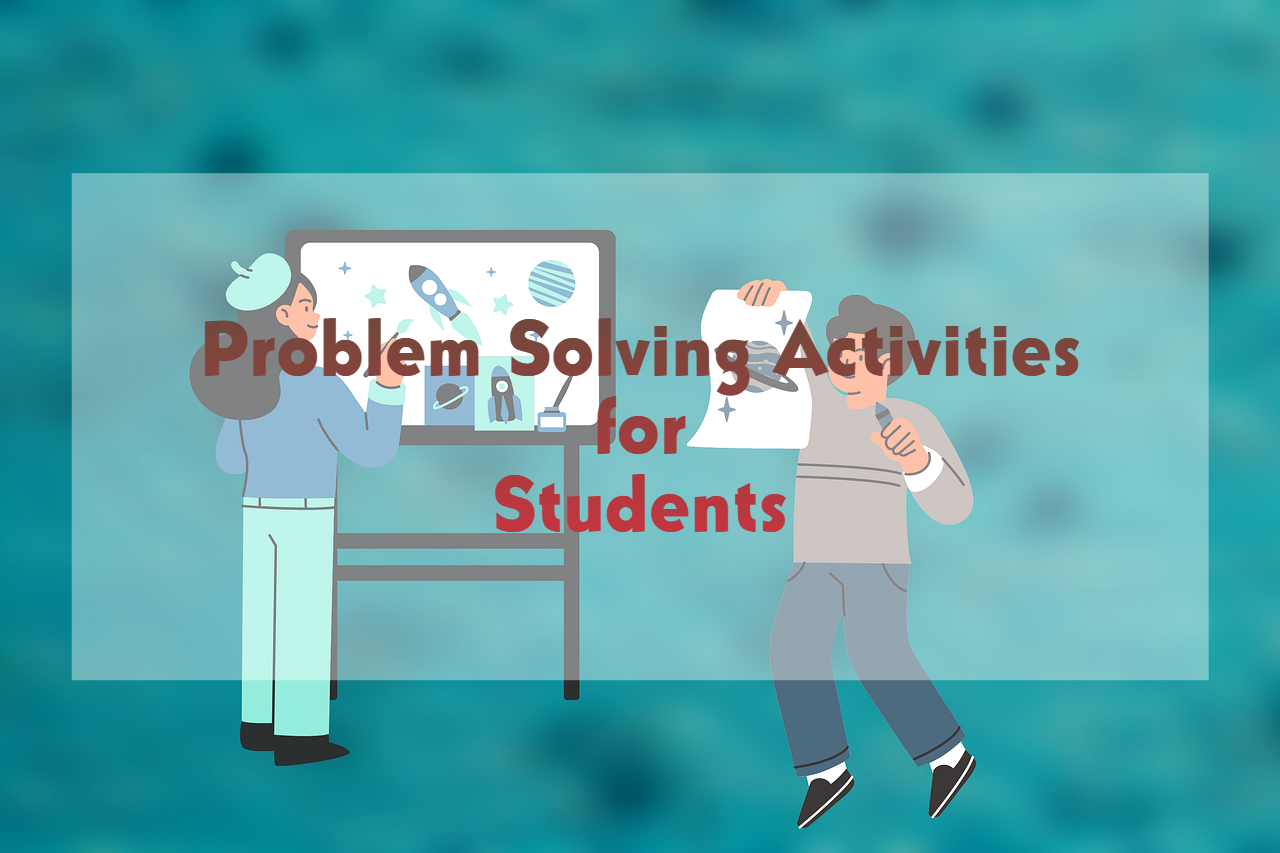Problem Solving Activities for Students
Written by: Abu-bakar
Engaging students in problem-solving activities is a great way to develop their critical thinking, creativity, and analytical skills. Here are several problem-solving activities suitable for different age groups and educational settings
Problem-solving activities are an essential component of a comprehensive educational experience, aimed at developing students’ critical thinking, creativity, and analytical skills. These activities challenge students to think beyond rote memorization and standardized testing, encouraging them to engage deeply with content and apply their knowledge in practical, often collaborative, scenarios.
Related Article: Why Critical Thinking is Important?

- Brainstorming Sessions
Objective: Encourage creative thinking and idea generation. Activity: Present a problem or question to the class. Have students brainstorm solutions individually or in groups, then share and discuss the ideas. Example: How can we reduce waste in our school?
2. Escape Room Challenges
Objective: Promote teamwork, critical thinking, and problem-solving. Activity: Set up a classroom escape room with puzzles and clues related to the subject matter. Students must solve the puzzles to “escape” the room. Example: A history-themed escape room where students solve clues related to significant historical events.
- Mystery Boxes
Objective: Enhance creativity and resourcefulness. Activity: Provide each group with a box of random objects. Challenge them to use these objects to solve a given problem or complete a task. Example: Build a bridge using only the items in the box (e.g., straws, tape, paper clips).
- Real-World Scenarios
Objective: Apply classroom knowledge to real-world problems. Activity: Present students with real-world problems that require thoughtful solutions. Example: How can we design a community garden to maximize space and resources?
- Case Studies
Objective: Develop analytical and decision-making skills. Activity: Provide students with a case study related to their course material. Have them analyze the case and propose solutions. Example: A business case study where students must develop a marketing strategy for a new product.
- Role-Playing
Objective: Build empathy and perspective-taking. Activity: Assign roles to students and present them with a scenario where they must solve a problem from their character’s perspective. Example: A town hall meeting where students represent different community members debating a local issue.
- Logic Puzzles and Riddles
Objective: Improve logical reasoning and critical thinking. Activity: Challenge students with logic puzzles or riddles that require careful thinking to solve. Example: Present a series of clues and have students figure out the solution to a mystery.
- Design Thinking Projects
Objective: Foster innovation and user-centered problem-solving. Activity: Introduce the design thinking process and have students work through the stages: empathize, define, ideate, prototype, and test. Example: Design a product to help people with limited mobility.
- Collaborative Problem Solving
Objective: Enhance teamwork and collective problem-solving abilities. Activity: Give groups of students a complex problem that requires collaboration to solve. Example: Create a plan to improve the school’s recycling program.
- Debates
Objective: Develop reasoning and argumentation skills. Activity: Organize debates on various topics where students must use evidence and logical reasoning to support their positions. Example: Should the school implement a uniform policy?
- Service Learning Projects
Objective: Connect academic learning to community service. Activity: Have students identify a community issue and develop a project to address it. Example: Organize a campaign to raise awareness about local environmental issues.
- Math Problem-Solving Workshops
Objective: Enhance mathematical reasoning and application skills. Activity: Present complex math problems and guide students through different strategies to solve them. Example: Solve a real-life budgeting problem using algebraic equations.
- Science Experiments
Objective: Apply scientific methods to problem-solving. Activity: Conduct experiments where students must hypothesize, test, and analyze results to solve a scientific question. Example: Determine the most effective way to purify water using various filtration methods.
- Coding and Robotics Challenges
Objective: Develop computational thinking and programming skills. Activity: Provide students with coding or robotics challenges that require logical sequencing and problem-solving. Example: Program a robot to navigate through a maze.
- Project-Based Learning
Objective: Integrate knowledge across subjects to solve complex problems. Activity: Assign long-term projects where students must research, design, and implement solutions to real-world issues. Example: Develop a sustainable business model for a new company.
By incorporating these activities into the classroom, educators can create a dynamic learning environment that nurtures problem-solving skills and prepares students for the challenges of the real world.
The Importance of Problem-Solving Skills:
In today’s rapidly changing world, the ability to solve complex problems is more critical than ever. Employers across industries seek individuals who can think critically, adapt to new situations, and devise innovative solutions to unforeseen challenges. By incorporating problem-solving activities into the curriculum, educators can prepare students not only for academic success but also for real-world applications in their future careers.
TYPES OF GAMES HELP IN PROBLEM SOLVING ACTIVITES FOR STUDENTS
Various types of games can be highly effective in developing problem-solving skills among students. These games often engage students in critical thinking, strategic planning, creativity, and collaboration. Here are some types of games that help in problem-solving activities for students:

- Puzzle Games
Objective: Enhance logical reasoning and critical thinking.
Examples:
- Sudoku: Promotes logical thinking and pattern recognition.
- Crossword Puzzles: Enhances vocabulary and critical thinking as students must deduce words from given clues.
- Jigsaw Puzzles: Develops spatial reasoning and problem-solving skills by requiring players to fit pieces together to form a picture.
- Strategy Games
Objective: Improve strategic planning and decision-making.
Examples:
- Chess: Encourages forward-thinking and strategic planning.
- Checkers: Develops tactical skills and foresight.
- Risk: Teaches strategic thinking and risk assessment as players attempt to conquer territories.
- Simulation and Role-Playing Games
Objective: Foster creativity, empathy, and strategic thinking.
Examples:
- SimCity: Allows students to build and manage a city, teaching resource management and planning.
- Dungeons & Dragons: Enhances creativity, storytelling, and collaborative problem-solving as players navigate fantasy scenarios.
- The Sims: Encourages creative thinking and planning in life simulation contexts.
- Educational Video Games
Objective: Combine learning with interactive problem-solving.
Examples:
- Portal: A puzzle-platform game that involves spatial reasoning and physics-based problem solving.
- Mine craft Education Edition: Encourages creativity and problem-solving through building and exploration.
- Kerbal Space Program: Teaches physics and engineering principles as players design and launch spacecraft.
- Team-Building Games
Objective: Promote collaboration and teamwork.
Examples:
- Escape Room Games: Require players to solve puzzles and find clues to “escape” from a locked room.
- Treasure Hunts: Engage students in teamwork and strategic planning to find hidden objects or complete tasks.
- Collaborative Board Games: Games like “Pandemic” where players must work together to solve problems and achieve a common goal.
- Brain Teasers and Logic Puzzles
Objective: Enhance analytical thinking and problem-solving skills.
Examples:
- Rubik’s Cube: Develops spatial awareness and problem-solving strategies.
- Logic Grid Puzzles: Involve deductive reasoning to fill in grids based on given clues.
- Kauri: A number puzzle that combines elements of Sudoku and crossword puzzles.
- Math and Word Games
Objective: Strengthen numerical and language-based problem-solving.
Examples:
- Math Blaster: An educational game that improves math skills through engaging missions and challenges.
- Scrabble: Enhances vocabulary and strategic thinking as players create words on a board for points.
- Math Puzzles (e.g., Ken): Develops mathematical reasoning and problem-solving through numerical puzzles.
- Card Games
Objective: Promote strategic thinking and probability assessment.
Examples:
- Bridge: Encourages strategic planning and teamwork.
- Poker: Teaches probability, risk assessment, and strategic thinking.
- Set: A game of pattern recognition and quick thinking.
- Physical and Outdoor Games
Objective: Combine physical activity with problem-solving.
Examples:
- Obstacle Courses: Require strategic planning and teamwork to navigate.
- Capture the Flag: Involves strategy, planning, and teamwork.
- Scavenger Hunts: Encourage problem-solving, teamwork, and creativity in finding items or completing tasks.
- Interactive Story Games
Objective: Develop narrative understanding and decision-making.
Examples:
- Choose Your Own Adventure Books/Games: Require players to make decisions that affect the outcome of the story.
- Interactive Fiction (e.g., Zorn): Involves navigating and solving puzzles within a story.
Conclusion
Incorporating problem-solving activities into the educational curriculum is a powerful approach to developing essential skills in students. These activities, ranging from puzzle games and strategy games to simulation and role-playing games, provide a dynamic and engaging way for students to enhance their critical thinking, creativity, and analytical abilities.
Prepare students to tackle both academic challenges and real-world problems with confidence and competence. Educators who integrate these activities into their teaching practices can significantly enhance their students’ learning experiences and outcomes.

